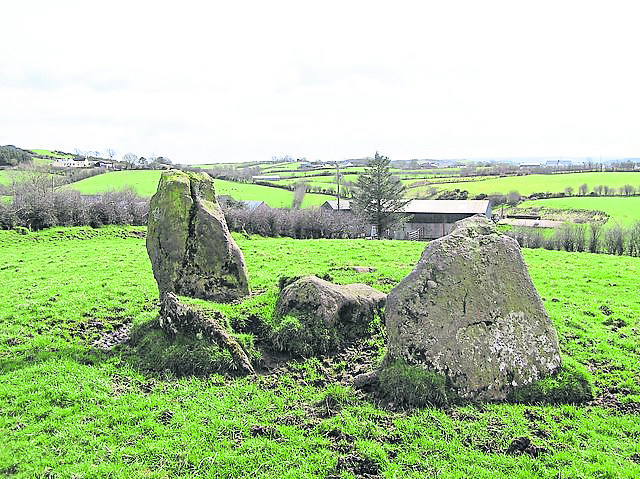PORTALS to other dimensions dot the Tyrone landscape… ancient markers of our rich prehistoric heritage. Dozens of megalithic structures line fields and backroads across the county, often passed without remark.
To many, they’re little more than oddly placed stones or embedded rocks. But centuries ago, these were sacred places with deep-rooted spiritual significance.
Portal tombs – also known as dolmens – are among the most iconic of Ireland’s megalithic monuments, alongside the less common court yombs, which were larger in layout but served a similar purpose.
They are easily recognisable with their huge capstones, often placed at an angle and supported by larger, upright stones, creating a chamber within – like a one-man shelter.
Originally, most portal tombs would have been surrounded by low earthen mounds or cairns, partially burying the uprights while leaving the capstone exposed.
The two standing stones flanking the entrance give these monuments their name: Portal tombs. It’s believed these tombs were built and used between 3800 and 3000 BCE by the same Neolithic communities responsible for court tombs.
As with court tombs, human remains have been discovered within portal tombs, indicating a shared ritual function most likely involving burial practices and ancestral reverence.
Their prominent settings and striking visual form suggest another purpose – to signal territory and tribal identity.
They may have acted as statements of presence or authority to outsiders, written in the visual language of stone and ceremony.
Portal tombs have long captivated the imagination.
Often called ‘Druids’ Altars’ or ‘Giants’ Graves’, they also feature in Irish mythology as ‘Leaba Diarmuid agus Gráinne’ – beds of the doomed lovers Diarmuid and Gráinne, who, pursued by Fionn Mac Cumhaill, were said to sleep on a different dolmen each night.
This romantic legend even gave rise to a tradition where couples hoping to conceive would spend a night at one of these ‘stone beds’, a practice that persisted into the 19th century.
Tyrone is home to many of these ancient structures, some still standing and others long weathered by time.
One such stone in Clogher, named ‘Carnfadrig’ or ‘Campatrick’, has associations with St Patrick.
Just a short distance from St Macartan’s PS, this large stone chamber is entered between two angled portal stones, one of which leans at a tilt.
First excavated in 1897, it yielded bones – some burned – along with flint and pottery.
Tradition links the site to St Patrick, who is believed to have journeyed through this valley from Armagh to meet St MacCairthinn.
Further north of Tyrone, near the border between Kesh and Castlederg, sits Scraghy Portal Tomb – also known as Crockalaghta, from the Irish Cnoc an Leachta, meaning ‘Hill of the Grave’.
Though it has collapsed, the tomb’s sheer scale and distinctive features remain impressive.
Its massive capstone measures 2.4 by 3.5 metres. Despite subsidence and damage over centuries, the original structure would likely have stood over two metres tall… an imposing landmark on the boggy hillside.
These are just two examples among many across Tyrone and Ireland. Increasingly, they’re being rediscovered by tourists and history-seekers, with many now signposted and featured online, offering modern visitors a glimpse into the spiritual world of our ancestors.







